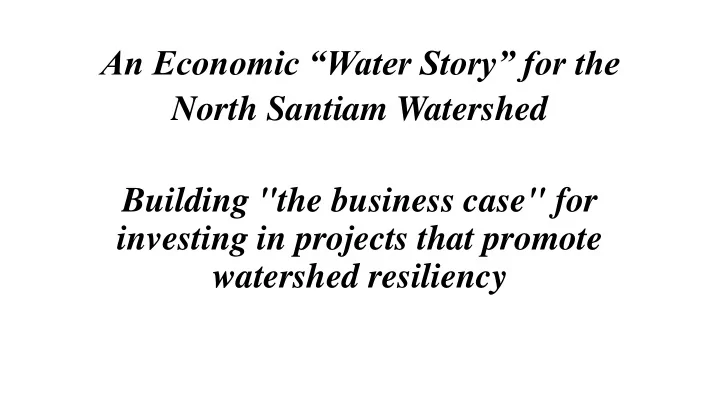

An Economic “Water Story” for the North Santiam Watershed Building "the business case" for investing in projects that promote watershed resiliency
NS Watershed Collaborative Planning Initiative • Since 2009 the City of Salem, Marion County and the NSWC have been holding annual North Santiam Basin Summits to assess and discuss critical watershed issues that could impact the watershed ecosystem and the people who depend on it. To date, topics covered include the following: watershed data management, emergency spill response, flooding, drought, and watershed scale planning. • In 2013, the stakeholders identified “drought emergency” as the highest priority for collaborative planning • In 2015, Santiam WCD received a 50/50 cost share BOR WaterSMART Grant to develop a North Santiam Drought Contingency Plan .
North Santiam Drought Contingency Plan North Santiam Drought Plan tries to answer the following three questions: 1. How will we recognize the next drought in the early stages? 2. How will drought affect us? 3. How can we protect ourselves from the next drought? Major Components of the Plan: Drought Monitoring * Vulnerability Assessment * Mitigation Actions* *Response Actions
Vulnerability Assessment & Mitigation Actions 1 . The Vulnerability Assessment identifies and evaluates the impacts of drought (water scarcity) on the assets and resources within the watershed, under current and future conditions. The underlying causes of impacts are also identified. The assessment was used to identify mitigation and response actions that would help reduce impacts on the assets. 2. Mitigation Actions reduce risks and impacts before drought. They are projects and programs to be implemented by individual organizations within the watershed, or collectively by the Drought Task Force
Drought Plan - Vulnerability Assessment Assets at Risk • Municipal water uses • Instream natural resources • Commercial crop irrigation • Commercial/industrial uses • Fire suppression • Individual domestic water • Water oriented recreation • Non-commercial irrigation • Hydropower • Upland natural resources • Other irrigation/watering
Mitigation Actions Identified by Drought Task Force Several Examples Irrigation District Piping/Automation – Piping of irrigation canals, automating system - increase water use efficiencies Salem Drinking Water Transmission Line – Fix leaking transmission pipes – increase water use efficiencies North Santiam Canyon – Develop waste water system – protect water quality & increase water use efficiency.
Partners of the North Santiam Mitigation/Restoration Actions Identified • In 2015, the Partners of the North Santiam Watershed was formed. It is a collaboration of local, state, federal agencies, and tribes along with non-profits, the business community, and other interested stakeholders that rely on the well-being of the North Santiam River Watershed. • Developing a North Santiam Basin Resiliency Action Plan • Identifying projects that address our vulnerabilities Resilience – The capacity of a community to anticipate, plan for, and mitigate the risks — and seize the opportunities — associated with environmental and social/economic change.
CIP & Non CIP Projects Identified by the Partners Fish Passage Flow Restoration Instream Enhancement Floodplain Restoration/Reconnection Riparian Restoration Invasive Vegetation Upland - Valley Habitat (Prairie, Oak Savanna & woodland) Upland- Forestry Upland -Urban/Storm water Land Conservation Planning- Fish Reintroduction Planning - Public Awareness & Outreach Planning- Recreation -Public Education & Outreach Planning- Flow Improvement Designs Planning - Recreation Site Designs Planning- Landowner Project Recruitment
Here we are today… We need funding to implement prioritized mitigation projects! When seeking funding you need to tell a compelling story… Why fund this project? Why here? Why now?
Building the case… Missing from “Our Water Story”… is the critical information that captures the economic data, in particular related to the industries dependent on the water resource of the basin both in and surrounding the watershed…and beyond What is the value of our water and watershed dependent resources? Invest here because…
Recommend
More recommend